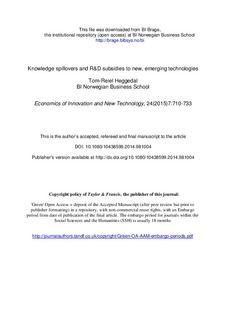| dc.contributor.author | Heggedal, Tom-Reiel | |
| dc.date.accessioned | 2015-07-30T08:42:52Z | |
| dc.date.available | 2015-07-30T08:42:52Z | |
| dc.date.issued | 2015 | |
| dc.identifier.citation | Economics of Innovation and New Technology, 24(2015)7:710-733 | nb_NO |
| dc.identifier.issn | 1043-8599 | |
| dc.identifier.issn | 1476-8364 | |
| dc.identifier.uri | http://hdl.handle.net/11250/293925 | |
| dc.description | This is the author’s accepted, refereed and final manuscript to the article | nb_NO |
| dc.description.abstract | Is knowledge spillover a rationale for supporting R&D on new, emerging technologies more than R&D on other technologies? In this paper, I analyze whether innovation externalities caused only by knowledge spillovers differ between technologies of different maturity. I show that R&D should not be subsidized equally across industries when the knowledge stocks differ. This is because knowledge spillovers depend on the size of the knowledge stock and the elasticity of scale in R&D production. R&D in the emerging technology should be subsidized more when the elasticity is smaller than one. However, R&D in the mature technology should be subsidized more when the elasticity is larger than one. | nb_NO |
| dc.language.iso | eng | nb_NO |
| dc.publisher | Taylor and Francis | nb_NO |
| dc.title | Knowledge spillovers and R&D subsidies to new, emerging technologies | nb_NO |
| dc.type | Journal article | nb_NO |
| dc.type | Peer reviewed | nb_NO |
| dc.source.journal | Economics of Innovation and New Technology | nb_NO |
| dc.identifier.doi | 10.1080/10438599.2014.981004 | |
| dc.description.localcode | 1, Forfatterversjon | nb_NO |
